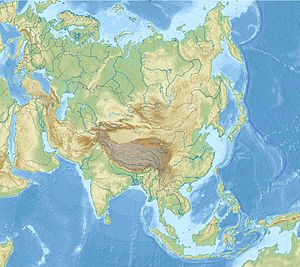Garland bearers
Garlands bearers, typically in the form of small naked putti holding up a continuous garland very large in relation to their size, formed a popular ornamental design in classical arts, from the Greco-Roman world to India, with ramifications as far as China. In Europe they were revived in the Renaissance, and continued in later periods.
Greco-Roman art
[edit]The garland-bearer design was extremely popular in the Mediterranean.[1] It first appeared at the end of the Hellenistic period, and its popularity expanded during the Roman period.[1] The design reached a peak of popularity in the 2nd century CE, adorning sarcophagi made in Asia Minor to be sold in Rome.[1]
Greek garland bearer designs tend to be continuous, and the garlands are furnished with leaves and stems.[1] Roman garland bearer designs are segmented and often use flowers and fruits for decoration.[1]
Garland bearers were also particularly associated to the cult of Dyonisos.[2]
-
Garland bearers on a Roman sarcophagus, 130-150 CE.
-
Greco-Roman garland bearers, Rockefeller Museum
-
Garland bearers on a sarcophagus, in Aphrodisias.
Central Asia
[edit]-
Capital with a figure showing features of Buddha and Heracles (100-200 CE), Old Termez Archaeological Museum.
Indian art
[edit]The erotes or putti holding garlands is one of the most common motif of the Greco-Buddhist art of Gandhara.[1] According to John Boardman, they find their origin in Hellenistic designs, rather than Roman ones.[1] The garlands had an important role in decorating Buddhist stupas.[4]
-
Yakshas holding Garlands, Peshawar Museum.
-
Garland and amorini, Gandhara, c. 2nd-3rd century CE
-
Garland bearers and Romaka Jataka (25-50 CE), Mathura Museum
-
Yaksha holding a garland, Amaravati stupa.
-
Erotes, garland and the Buddha on the Kanishka casket
-
Limestone coping fragment, Ter, Maharashtra.
-
Garland bearers, Amaravati stupa, India. Chennai Government Museum
China
[edit]The garland bearer design can be seen in Buddhist frescoes in Miran, China, from the 3rd century CE.
References
[edit]- ^ a b c d e f g Ladislav, Stančo (2012). Greek Gods in the East. Charles University in Prague, Karolinum Press. p. 116. ISBN 978-80-246-2045-9.
- ^ Boorstin, Daniel J. (2012). The Creators: A History of Heroes of the Imagination. Knopf Doubleday Publishing Group. p. 203. ISBN 978-0-307-81721-1.
- ^ Yi, Joy Lidu (January 2020). The Global Connections of Gandhāran Art. p. 56.
- ^ "The garland is a very significant ornament used for the purpose of decoration on the stupas by the devotees. The devotees who carry garlands are called the 'garland-bearers'" Proceedings volume of the 18 th Annual Conference. South Indian Historical Congress. 1999. p. 342.







![Roman marble sarcophagus with segmented garlands decorated with flowers and fruits, 200-225 CE, Tarsus, Cilicia (modern Turkey).[3]](http://upload.wikimedia.org/wikipedia/commons/thumb/3/31/Marble_sarcophagus_with_garlands_200-225_CE_Tarsus%2C_Cilicia_%28modern_Turkey%29.jpg/217px-Marble_sarcophagus_with_garlands_200-225_CE_Tarsus%2C_Cilicia_%28modern_Turkey%29.jpg)











